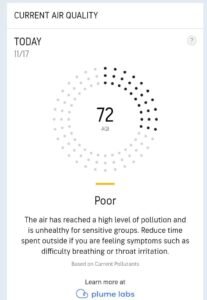 Report: SUNEEL KUMAR
Report: SUNEEL KUMAR
Climate change and environmental degradation are global challenges, but their impacts are felt most acutely in urban centers like Karachi. As cities grow, the strain on natural ecosystems and resources intensifies, leading to a cascade of environmental issues, including deteriorating air quality. Karachi, Pakistan’s economic hub, is now facing one of the most visible and harmful manifestations of this crisis—smog.
The Current Situation in Karachi
Today, Karachi’s air quality is classified as Poor, with an Air Quality Index (AQI) of 80, signaling significant health risks, especially for vulnerable groups. The city’s sky is veiled in smog, a toxic mix of pollutants that reduces visibility and threatens public health.
PM2.5 Levels: 22 µg/m³ (Poor) These fine particles, smaller than 2.5 micrometers, can penetrate deep into the lungs and bloodstream, causing long-term respiratory and cardiovascular diseases.
PM10 Levels: 45 µg/m³ (Poor) Larger particles also contribute to respiratory irritation, coughing, and eye discomfort. Ozone (O3) and Nitrogen Dioxide (NO2): Both pollutants currently remain at Excellent levels, offering a glimmer of relief in an otherwise challenging air quality scenario.
Despite these variations, the overarching concern remains the high levels of particulate matter, which pose an immediate threat to health.
Smog and Climate Interconnection
The smog crisis in Karachi cannot be divorced from the broader context of climate change. Rising global temperatures and changing weather patterns exacerbate urban air pollution by: Temperature Inversions: During cooler months, warm air traps pollutants close to the ground, intensifying smog.
Increased Dust and Particulates: Erratic weather patterns, coupled with deforestation and poor urban planning, allow more dust to remain airborne.
Energy Demands: Higher energy consumption leads to greater emissions from fossil fuel-based power plants and vehicles.
Causes of Smog in Karachi
Karachi’s smog is a complex issue driven by a combination of natural and human-made factors: Vehicular Emissions: The city’s overburdened roads are packed with vehicles emitting nitrogen oxides and particulate matter.
Industrial Activities: Factories operating without proper emission controls contribute heavily to air pollution. Construction Dust: Unchecked construction projects release significant amounts of particulate matter into the atmosphere. Waste Burning: Open-air burning of waste, including hazardous materials like plastic, emits dangerous toxins into the air.
Health Implications of Smog: Smog poses serious health risks, particularly to children, the elderly, and individuals with pre-existing conditions. Prolonged exposure can result in:
Respiratory Problems: Difficulty breathing, throat irritation, and coughing. Chronic Diseases: Increased risk of asthma, bronchitis, and even cardiovascular conditions. Reduced Quality of Life: Persistent eye irritation, fatigue, and headaches.
How Karachi Residents Can Cope? While systemic solutions are necessary, individuals can take immediate steps to reduce their exposure: Limit Outdoor Activities: Avoid outdoor exercise during peak smog hours. Use Masks: Wear protective masks that can filter fine particles. Air Purifiers: Use indoor air purifiers to maintain cleaner air inside homes.
The Path Forward addressing Karachi’s smog crisis requires urgent and coordinated action: Stricter Emission Controls: Enforcement of pollution regulations on vehicles and industries. Sustainable Urban Planning: Incorporating green spaces and better waste management systems. Public Awareness: Educating the public about the causes and impacts of smog to foster a collective sense of responsibility. Investment in Clean Energy: Reducing reliance on fossil fuels to curb emissions. Karachi’s smog is a stark reminder of the broader climate and environmental challenges we face. While individual efforts can mitigate personal risks, long-term solutions demand systemic changes that prioritize sustainability and public health.
The battle against smog is not just a fight for cleaner air—it is a fight for a healthier, more resilient Karachi.
